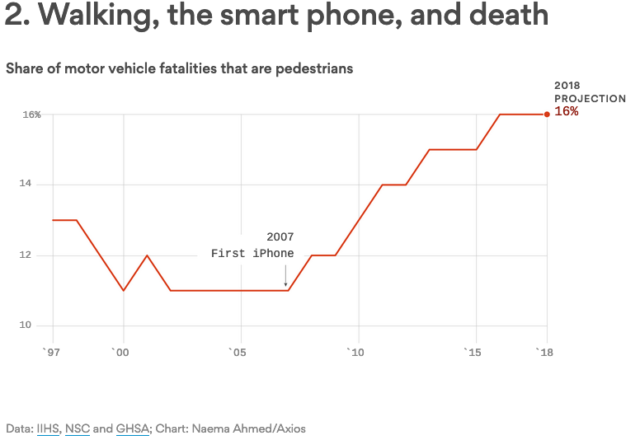Mission: To promote driving less so all may live more.
Smart phone usage prompts this post. Nearly every driver knows the dangers, but not every driver feels the dangers. Hence the advantage of being a pedestrian. Frankly I’m surprised there are not more car-to-car, car-to-bike, and car-to-pedestrian collisions. The human body and mind are wonderfully made.
The underlying problem is of course distraction. Drivers were instructed to “keep your eyes on the road” long before the mobile phone. But somehow people like myself hone in on texting and map reading as the biggest threat.
Tommy, Can You See Me?
One comedian says he feels safer with intoxicated drivers on the road than around texting drivers. At least with the intoxicated driver, he pleads, there’s someone driving.
I know what he means—as does a Utah study that suggests people using cell phones had a slower reaction time than drunk drivers.[1]
The graph below suggests the increase of iPhones and the increase of pedestrians killed by cars are related:

(Click here for the embedded web page with its additional commentary on the role of SUVs )
Approximately 6 additional pedestrian deaths of every 100 result from smart phones. The statistic probably cuts both ways: surely pedestrians are distracted from cars while they focus on their mobile device.
A bus driver recently told me (adamantly) that mobile phones should be automatically shut off in automobiles. His opinion gains authority from his eagle-eye view and exposure to driving habits. That, my friendly driver, will never happen. What is less unlikely is for governments to require smart phone screens to go black when in visible proximity of a driver.[2] Yes, there would be an emergency override for…uh…emergencies.[3]
Tommy, Can You Hear Me?
Unfortunately, turning off smart phone screens near drivers would be insufficient. Sound, also, should be turned off.
Here’s a chilling account of an accident that appeared to be caused purely by audial, not visual, distraction:
In January 2004, at 4:00 p.m., in Grand Rapids, Michigan, a 20-year- old woman ran a red light while talking on a cell phone. The driver’s vehicle slammed into another vehicle crossing with the green light directly in front of her. The vehicle she hit was not the first car through the intersection, it was the third or fourth. The police investigation determined the driver never touched her brakes and was traveling 48 mph when she hit the other vehicle. The crash cost the life of a 12-year-old boy. Witnesses told investigators that the driver was not looking down, not dialing the phone, or texting. She was observed looking straight out the windshield talking on her cell phone as she sped past four cars and a school bus stopped in the other south bound lane of traffic.[4]
Studies show that hands-free driving makes no statistical difference in the number of accidents. The same appears to apply to hands-free texting.
A writer in Scientific American believed that voice-controlled texting (like hands-free driving) would be significantly safer than manual texting. He recanted. Then he reconsidered, but ultimately conceded that even voice-controlled texting is too dangerous to perform. His conclusions were based on a 2013 study from Texas A&M Transportation Institute.
Can You Feel Me Near You?
The root problem lies in the mind. One can have his or her eyes on the road, one ear open, and still, if involved in any other task beside driving, be more likely to hit somebody or something. A study produced by the AAA and referred to in a Nightline clip claimed that the biggest crash-related distraction occurs when drivers talk to someone else in the car.
Oooh, Tommy
Here’s the clip from Nightline. Might be more compelling if the driver crashed while talking to the expert about the dangers of talking while driving (because, while the driver keeps her eyes on the road, several studies suggest it’s the mental distraction—not the visual—that is most dangerous). (Viewer caution: After the first few seconds the video gets unnecessarily depressing—unlike my posts!)
____Footnotes____
[1] Found in a section called “Driving risks of hands-free and handheld cell phones” of the National Safety Council publication, Cell Phone Policy Kit. The study is cited on page 19 (using the PDF numbering, not the footer numbering).
[2] Obviously the facial recognition capabilities of smart phones bring the technology right to the doorstep of this dictum: driver looks at the phone, it scans his/her face, detects eye contact, turns off screen.
[3] The override would be similar to pushing my iPhone SE’s “on” button five times. It gives 3 options:
- turn off the phone—which requires a passcode instead of a finger print to turn back on again; this means there’s a chance the police cannot make you turn on your phone since a passcode may be protected by the Fifth Amendment (https://nakedsecurity.sophos.com/2018/11/01/passcodes-are-protected-by-fifth-amendment-says-court/)
- display my medical ID (which in my case amounts to a local friend’s phone number)
- call 911 (“Emergency SOS”)
[4] Found in a white paper called “Understanding the distracted brain” of the National Safety Council publication, Cell Phone Policy Kit. The study is cited on page 10 (using the PDF numbering, not the footer numbering).
